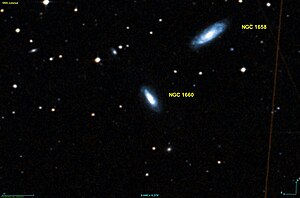NGC 1660
| Galaxy NGC 1660 |
|
|---|---|

|
|
| AladinLite | |
| Constellation | Digger |
|
Position equinox : J2000.0 , epoch : J2000.0 |
|
| Right ascension | 04 h 44 m 11.4 s |
| declination | -41 ° 29 ′ 51 ″ |
| Appearance | |
| Morphological type | Sa? / pec |
| Brightness (visual) | 14.0 mag |
| Brightness (B-band) | 14.9 mag |
| Angular expansion | 1 ′ × 0.5 ′ |
| Position angle | 32 ° |
| Surface brightness | 13.9 mag / arcmin² |
| Physical data | |
| Redshift | 0.020891 ± 0.000260 |
| Radial velocity | 6263 ± 78 km / s |
|
Stroke distance v rad / H 0 |
(272 ± 19) x 10 6 ly (83.5 ± 5.9) Mpc |
| history | |
| discovery | John Herschel |
| Discovery date | December 1, 1837 |
| Catalog names | |
| NGC 1660 • PGC 15908 • ESO 304-018 • MCG -07-10-021 • IRAS F04424-4134 • 2MASX J04441142-4129513 • SGC 044233-4135.3 • GALEX ASC J044411.37-412950.4 | |
NGC 1660 is a spiral galaxy of the Hubble type Sa in the constellation Gravestones in the southern sky . It is estimated to be 272 million light years from the Milky Way and about 80,000 light years in diameter .
The galaxy NGC 1658 is located in the same area of the sky .
The object was discovered by John Herschel on December 1, 1837 .
